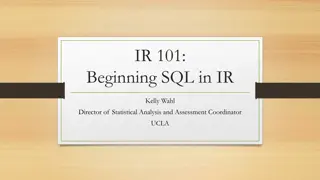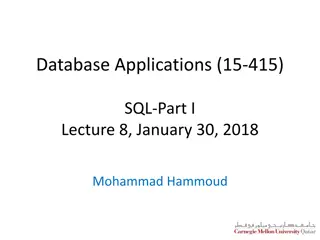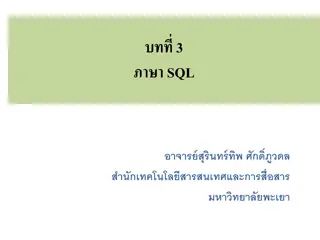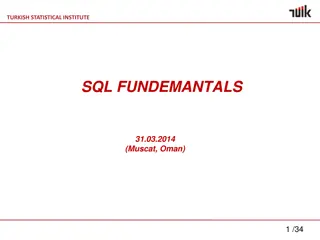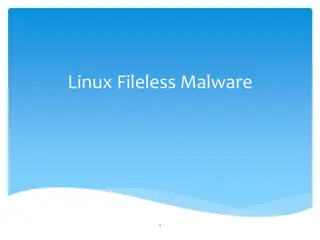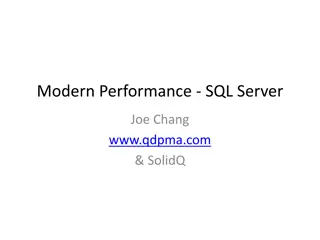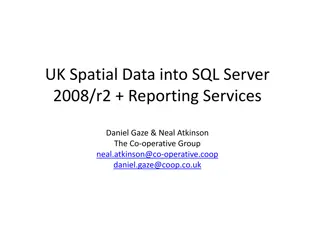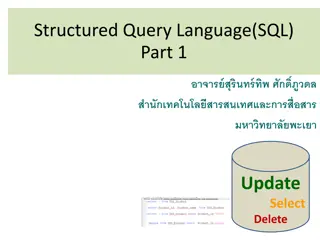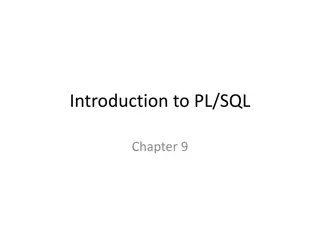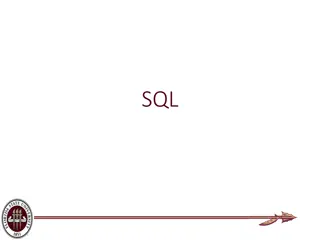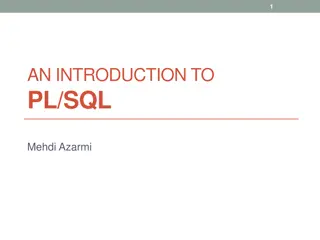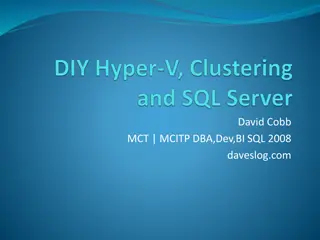SQL Injection: Risks and Safeguards
SQL Injection is a critical code injection technique that hackers exploit to compromise data-driven web applications. By injecting malicious code into SQL statements, attackers can manipulate program execution and gain unauthorized access to sensitive information. The vulnerability arises from inadequate user input filtering and weak data typing, making applications susceptible to unauthorized commands. Learn about the mechanics of SQL Injection, its repercussions, and preventive measures to bolster cybersecurity defenses against this prevalent attack vector.
Download Presentation

Please find below an Image/Link to download the presentation.
The content on the website is provided AS IS for your information and personal use only. It may not be sold, licensed, or shared on other websites without obtaining consent from the author.If you encounter any issues during the download, it is possible that the publisher has removed the file from their server.
You are allowed to download the files provided on this website for personal or commercial use, subject to the condition that they are used lawfully. All files are the property of their respective owners.
The content on the website is provided AS IS for your information and personal use only. It may not be sold, licensed, or shared on other websites without obtaining consent from the author.
E N D
Presentation Transcript
Hack Attack Series: SQL Injection By Collin Donaldson
DISCLAIMER Hacking is only legal under the following circumstances: 1. You hack (penetration test) a device/network you own. 2. You gain explicit, documented permission from an individual, assumedly a friend. 3. You acquire an Ethical Hacker Certification and hack for a public or private sector organization with explicit permission to do so. This is the safest of the three methods. Hacking is illegal in all other circumstances. Hackers can be charged with fines, misdemeanors, and/or felonies depending on severity and accounts of hacks. For these reasons I will not be demonstrating any live hacking attempts in the wild. For more information http://definitions.uslegal.com/c/computer-hacking/
Definition A type of code injection. Code injection is when a hacker exploits a computer vulnerability that allows invalid data to be processed. The hacker introduces or injects a malicious virus/script/command into the program to change the program s execution. SQL injection is one of the most popular forms of code injection and is used to hack data-driven web applications that use SQL or a derivative of SQL. SQL is a type of vector, which means it is designed to infiltrate a system and than propagate itself. Buffer overflow is a related technique that is also a vector. In nature, a vector is any animal that carries a biological virus, such as rats /fleas carrying bubonic plague or mosquitos carrying malaria or West Nile virus.
How it works and why The vulnerability happens when user input is either incorrectly filtered for string literal escape characters embedded in SQL statements or user input is weakly typed and unexpectedly executed. String literal escape characters are characters that initiate different controls in a program (authenticate, end program, etc.). If a program is incorrectly filtered it will not reject other characters such as (#, <, >, =, *, etc.) Weak-typed means the software was written in a language that does not support memory safety, type safety, static type safety, or dynamic type safety. Java is strongly typed, however C++ is weakly typed and it is what SQL is written in. Hence why SQL is a popular target.
Step One: Casing Find a website with a URL that looks like one of the following example: http://www.hackingstuffs.com/items.php?id=5 Look for the php?id=5 note: can be any number after the = sign. Now type an invalid string literal escape character after the last character in the URL, in this case after the 5 . An apostrophe or pound sign # are recommended. If the site produces and error such as syntax error or error on line 23 or any similar error, the website you found is vulnerable to an SQL injection. If an error is not produced, search for a new website.
Step Two: Choose method of injection There are many ways to launch an SQL injection. Here are two common ones. SQL Tag Injection: Type a pound sign (#) into the websites URL followed by malicious code. SQL tags use a format like this: #TABLE1_SELECT_ROW2ksd9204255nazx If you know SQL than you can give the table commands remotely, including pasting in source code for viruses. This method is more flexible and allows a wider range of options, yet for simplicity sake we will use a second option. The second option: a generic SQL injection.
Step Three: Find a login/admin page Look for a page with a URL similar to the following: http://www.hackingstuffs.com/login.php http://www.hackingstuffs.com/admin_login.php You can also use an SQL injection tool to help you find the login page, some examples being Absinthe, Havij, or sqlmap. We will not cover the use of tools however. Now it is time to launch the SQL Injection attack.
Step 4: Launching the Attack Type any of the following on the username and password section of the login page 1 OR 1 = 1 1 OR 1=1 1 1 1 AND 1=1 1 EXEC SP_ (or EXEC XP_) 1 AND 1=(SELECT COUNT(*) FROM tablenames); If none of the codes work, look for more by searching SQL Injection Codes
Step 5: Malicious Activity You are now in the system and have successfully hacked a website. Congratulations! At this point, you may want to leave (if you are only hacking to learn that is). You now have full reign over an SQL database. What you do with the database is up to you. You can access and edit the database like any other user, except that you have to hack in again (unless you inject a script that opens a backdoor to the database you can use). For more information on what you can do once inside, refer to the following: http://www.unixwiz.net/techtips/sql-injection.html
OR YOU DECIDE





